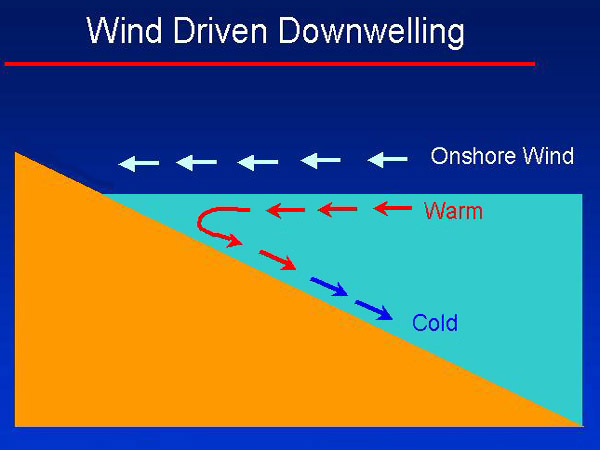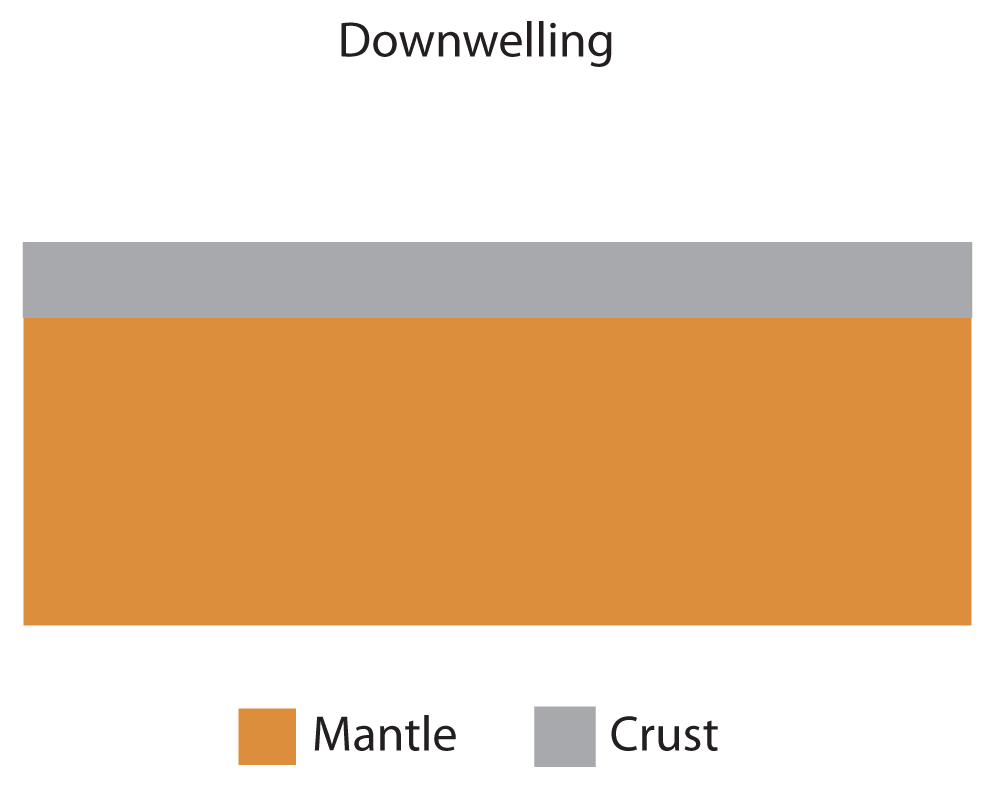Downwelling on:
[Wikipedia]
[Google]
[Amazon]
 Downwelling is the process of accumulation and sinking of higher density material beneath lower density material, such as cold or saline
Downwelling is the process of accumulation and sinking of higher density material beneath lower density material, such as cold or saline
 Downwelling occurs in anti-cyclonic regions of the ocean where warm rings spin clockwise, causing surface convergence. When these surface waters converge, the surface water is pushed downwards. Downwelling can also occur as a result of the wind driving the sea towards the coastline. Downwelling regions have low productivity because the nutrients in the water column are used but are not continuously replenished by cold, nutrient-rich water from below the surface.
Downwelling occurs in anti-cyclonic regions of the ocean where warm rings spin clockwise, causing surface convergence. When these surface waters converge, the surface water is pushed downwards. Downwelling can also occur as a result of the wind driving the sea towards the coastline. Downwelling regions have low productivity because the nutrients in the water column are used but are not continuously replenished by cold, nutrient-rich water from below the surface.
 Downwelling can also be observed on the Earth's mantle and is one of the models used to explain the formation of tessera on Venus.
Downwelling can also be observed on the Earth's mantle and is one of the models used to explain the formation of tessera on Venus.
Wind Driven Surface Currents: Upwelling and DownwellingDuluth's Beach Water Temperatures: Upwelling and Downwelling
{{physical oceanography
Duluth's Beach Water Temperatures: Upwelling and Downwelling
Oceanography Meteorological phenomena
 Downwelling is the process of accumulation and sinking of higher density material beneath lower density material, such as cold or saline
Downwelling is the process of accumulation and sinking of higher density material beneath lower density material, such as cold or saline water
Water (chemical formula ) is an inorganic, transparent, tasteless, odorless, and nearly colorless chemical substance, which is the main constituent of Earth's hydrosphere and the fluids of all known living organisms (in which it acts as ...
beneath warmer or fresher water or cold air beneath warm air. It is the ''sinking'' limb of a convection cell
In the field of fluid dynamics, a convection cell is the phenomenon that occurs when density differences exist within a body of liquid or gas. These density differences result in rising and/or falling currents, which are the key characteristics ...
. Upwelling
Upwelling is an physical oceanography, oceanographic phenomenon that involves wind-driven motion of dense, cooler, and usually nutrient-rich water from deep water towards the ocean surface. It replaces the warmer and usually nutrient-depleted ...
is the opposite process, and together, these two forces are responsible in the oceans for the thermohaline circulation. The sinking of the cold lithosphere
A lithosphere () is the rigid, outermost rocky shell of a terrestrial planet or natural satellite. On Earth, it is composed of the crust and the portion of the upper mantle that behaves elastically on time scales of up to thousands of years ...
at subduction zones is another example of downwelling in plate tectonics
Plate tectonics (from the la, label= Late Latin, tectonicus, from the grc, τεκτονικός, lit=pertaining to building) is the generally accepted scientific theory that considers the Earth's lithosphere to comprise a number of larg ...
.
Oceanic downwelling
Oxygenation
Downwelling also allows for deep ocean oxygenation to occur because these waters are able to bring dissolved oxygen down from the surface to help facilitateaerobic respiration
Cellular respiration is the process by which biological fuels are oxidised in the presence of an inorganic electron acceptor such as oxygen to produce large amounts of energy, to drive the bulk production of ATP. Cellular respiration may be des ...
in organisms throughout the water column. Without this renewal, the dissolved oxygen in the sediment and within the water column would be quickly used up by biological processes and anaerobic bacteria
An anaerobic organism or anaerobe is any organism that does not require molecular oxygen for growth. It may react negatively or even die if free oxygen is present. In contrast, an aerobic organism (aerobe) is an organism that requires an oxygenat ...
would take over decomposition, leading to a build-up of hydrogen sulfide
Hydrogen sulfide is a chemical compound with the formula . It is a colorless chalcogen-hydride gas, and is poisonous, corrosive, and flammable, with trace amounts in ambient atmosphere having a characteristic foul odor of rotten eggs. The under ...
. In these toxic conditions, there are very few benthic animals that would survive. In the most extreme cases, a lack of downwelling could possibly lead to mass extinction. Paleontologists have suggested that 250 million years ago, deep ocean ventilation slowed nearly to a halt, and the ocean became stagnant. Sulfide and methane-rich waters low on oxygen filled the deep ocean and progressed onto the continental shelves, wiping out 95% of all marine species in the greatest extinction event in Earth's history, the Permian extinction.
Locations
Downwelling occurs in polar regions where ice formation causes the remaining water to become saltier and therefore denser, in the subpolar gyre of theNorth Atlantic
The Atlantic Ocean is the second-largest of the world's five oceans, with an area of about . It covers approximately 20% of Earth's surface and about 29% of its water surface area. It is known to separate the " Old World" of Africa, Europe a ...
where several surface currents meet, and where cold waters meet warmer waters, such as along the outermost boundary of the Southern Ocean
The Southern Ocean, also known as the Antarctic Ocean, comprises the southernmost waters of the World Ocean, generally taken to be south of 60° S latitude and encircling Antarctica. With a size of , it is regarded as the second-smal ...
where cold Antarctic water sinks below warmer South Pacific and South Atlantic waters. There is also downwelling on a few coastlines where the wind blows in such a direction that it causes Ekman transport
Ekman transport is part of Ekman motion theory, first investigated in 1902 by Vagn Walfrid Ekman. Winds are the main source of energy for ocean circulation, and Ekman Transport is a component of wind-driven ocean current. Ekman transport occurs w ...
to move water towards the coast, which then causes the water to pile up and be pushed down.
Mantle downwelling
 Downwelling can also be observed on the Earth's mantle and is one of the models used to explain the formation of tessera on Venus.
Downwelling can also be observed on the Earth's mantle and is one of the models used to explain the formation of tessera on Venus.
See also
* * *References
External links
Wind Driven Surface Currents: Upwelling and Downwelling
{{physical oceanography
Duluth's Beach Water Temperatures: Upwelling and Downwelling
Oceanography Meteorological phenomena